Security Threats and Promising Solutions Arising from the Intersection of AI and IoT: A Study of IoMT and IoET Applications
Abstract
1. Introduction
2. Role of AI and IoT in the Hyperconnected Intelligent World
2.1. Energy Theft Detection
2.2. Remote Intelligent Stress Monitoring
2.3. Security Threats in IoT
3. Malware Attack and Effective Detection Method
3.1. Privacy Risks under Malware Attack
3.2. Artificial Immune Systems (AIS) for Detecting Malware Attacks in IoT
4. Man-in-the-Middle (MITM) Attacks
4.1. Federating Learning to Mitigate MITM Attacks: An IoET Case
| Clients | Accuracy | Precision | Recall | F1 Score | TPR | FPR | Cost (K£) | |
|---|---|---|---|---|---|---|---|---|
| Central | CNN-B [2] | 89.60 | 72.19 | 89.93 | 30.20 | 65.58 | 2890 | |
| CNN-B † | 91.82 | 94.19 | 91.83 | 63.10 | 81.75 | 7.23 | 1415 | |
| 2 | 87.75 | 91.90 | 87.75 | 49.29 | 69.64 | 10.55 | 2277 | |
| FL- | 5 | 80.53 | 90.34 | 80.53 | 37.11 | 67.22 | 18.23 | 2818 |
| CNN | 10 | 72.47 | 88.09 | 72.47 | 24.39 | 64.43 | 27.44 | 3460 |
| Fed | 2 | 91.98 | 91.00 | 91.98 | 40.18 | 34.77 | 3.21 | 3871 |
| Detect | 5 | 92.58 | 91.03 | 92.58 | 36.07 | 27.03 | 1.91 | 4242 |
| 10 | 92.55 | 90.53 | 92.55 | 25.39 | 16.37 | 1.0 | 4799 |
- : The parameter vector for the i-th client or model at iteration t.
- n: The total number of clients or models in the learning process.
- : The learning rate, a positive scalar that determines the step size in the direction of the negative gradient.
- : The gradient of the loss function with respect to the parameter vector for the i-th client or model at iteration .
4.2. Differential Privacy to Mitigate MITM Attacks: An IoMT Case
5. Privacy Evaluation Methods
6. Remaining Challenges
6.1. Risk of Model Stealing
6.2. Assumptions on the Threat Model
7. Conclusions
Author Contributions
Funding
Data Availability Statement
Conflicts of Interest
References
- Alshareef, M.S.; Alturki, B.; Jaber, M. A transformer-based model for effective and exportable IoMT-based stress detection. In Proceedings of the GLOBECOM 2022—2022 IEEE Global Communications Conference, Rio de Janeiro, Brazil, 4–8 December 2022; pp. 1158–1163. [Google Scholar] [CrossRef]
- Nadeem, Z.; Aslam, Z.; Jaber, M.; Qayyum, A.; Qadir, J. Energy-aware Theft Detection based on IoT Energy Consumption Data. In Proceedings of the 2023 IEEE 97th Vehicular Technology Conference (VTC2023-Spring), Florence, Italy, 20–23 June 2023; IEEE: Florence, Italy, 2023; pp. 1–6. [Google Scholar] [CrossRef]
- De, S.J.; Métayer, D.L. Privacy Harm Analysis: A Case Study on Smart Grids. In Proceedings of the 2016 IEEE Security and Privacy Workshops (SPW), San Jose, CA, USA, 22–26 May 2016; pp. 58–65. [Google Scholar] [CrossRef]
- Tayyab, U.e.H.; Khan, F.B.; Durad, M.H.; Khan, A.; Lee, Y.S. A Survey of the Recent Trends in Deep Learning Based Malware Detection. J. Cybersecur. Priv. 2022, 2, 800–829. [Google Scholar] [CrossRef]
- Alrubayyi, H.; Goteng, G.; Jaber, M.; Kelly, J. Challenges of Malware Detection in the IoT and a Review of Artificial Immune System Approaches. J. Sens. Actuator Netw. 2021, 10, 61. [Google Scholar] [CrossRef]
- Abdelmoniem, A.M.; Sahu, A.N.; Canini, M.; Fahmy, S.A. REFL: Resource-Efficient Federated Learning. In Proceedings of the Eighteenth European Conference on Computer Systems (EuroSys), Rome, Italy, 8–12 May 2023. [Google Scholar]
- Muhsen, D.H.; Haider, H.T.; Al-Nidawi, Y.; Shayea, G.G. Operational Scheduling of Household Appliances by Using Triple-Objective Optimization Algorithm Integrated with Multi-Criteria Decision Making. Sustainability 2023, 15, 16589. [Google Scholar] [CrossRef]
- Afonso, J.A.; Monteiro, V.; Afonso, J.L. Internet of Things Systems and Applications for Smart Buildings. Energies 2023, 16, 2757. [Google Scholar] [CrossRef]
- Wang, B.; Ma, H.; Wang, F.; Dampage, U.; Al-Dhaifallah, M.; Ali, Z.M.; Mohamed, M.A. An IoT-Enabled Stochastic Operation Management Framework for Smart Grids. IEEE Trans. Intell. Transp. Syst. 2023, 24, 1025–1034. [Google Scholar] [CrossRef]
- González-Vidal, A.; Mendoza-Bernal, J.; Niu, S.; Skarmeta, A.F.; Song, H. A Transfer Learning Framework for Predictive Energy-Related Scenarios in Smart Buildings. IEEE Trans. Ind. Appl. 2023, 59, 26–37. [Google Scholar] [CrossRef]
- Abdulmalek, S.; Nasir, A.; Jabbar, W.A.; Almuhaya, M.A.M.; Bairagi, A.K.; Khan, M.A.M.; Kee, S.H. IoT-Based Healthcare-Monitoring System towards Improving Quality of Life: A Review. Healthcare 2022, 10, 1993. [Google Scholar] [CrossRef]
- Alshehri, F.; Muhammad, G. A Comprehensive Survey of the Internet of Things (IoT) and AI-Based Smart Healthcare. IEEE Access 2021, 9, 3660–3678. [Google Scholar] [CrossRef]
- Mental Health Foundation. Stress: Are We Coping? Available online: https://www.mentalhealth.org.uk/explore-mental-health/publications/stress-are-we-coping-report (accessed on 28 December 2023).
- Garg, P.; Santhosh, J.; Dengel, A.; Ishimaru, S. Stress detection by machine learning and wearable sensors. In Proceedings of the 26th International Conference on Intelligent User Interfaces-Companion, College Station, TX, USA, 14–17 April 2021; pp. 43–45. [Google Scholar]
- Bouramdane, A.A. Cyberattacks in Smart Grids: Challenges and Solving the Multi-Criteria Decision-Making for Cybersecurity Options, Including Ones That Incorporate Artificial Intelligence, Using an Analytical Hierarchy Process. J. Cybersecur. Priv. 2023, 3, 662–705. [Google Scholar] [CrossRef]
- Alanazi, F.; Kim, J.; Cotilla-Sanchez, E. Load Oscillating Attacks of Smart Grids: Vulnerability Analysis. IEEE Access 2023, 11, 36538–36549. [Google Scholar] [CrossRef]
- Saleem, M. Brexit Impact on Cyber Security of United Kingdom. In Proceedings of the 2019 International Conference on Cyber Security and Protection of Digital Services (Cyber Security), Oxford, UK, 3–4 June 2019; pp. 1–6. [Google Scholar] [CrossRef]
- Outdated Software Leaves NHS ‘Vulnerable to Cyber Attack’. 2019. Available online: https://www.digitalhealth.net/2019/04/outdated-software-leaves-nhs-vulnerable-to-cyber-attack-new-research-says/ (accessed on 28 December 2023).
- Hilt, S.; Kropotov, V.; Mercês, F.; Rosario, M.; Sancho, D. The Internet of Things in the cybercrime underground. Trend Micro Res. 2019. Available online: https://media.rbcdn.ru/media/reports/wp-the-internet-of-things-in-the-cybercrime-underground.pdf (accessed on 28 December 2023).
- Thamilarasu, G.; Odesile, A.; Hoang, A. An Intrusion Detection System for Internet of Medical Things. IEEE Access 2020, 8, 181560–181576. [Google Scholar] [CrossRef]
- Hatzivasilis, G.; Soultatos, O.; Ioannidis, S.; Verikoukis, C.; Demetriou, G.; Tsatsoulis, C. Review of Security and Privacy for the Internet of Medical Things (IoMT). In Proceedings of the 2019 15th International Conference on Distributed Computing in Sensor Systems (DCOSS), Santorini, Greece, 29–31 May 2019; pp. 457–464. [Google Scholar] [CrossRef]
- Alrubayyi, H.; Goteng, G.; Jaber, M. AIS for Malware Detection in a Realistic IoT System: Challenges and Opportunities. Network 2023, 3, 522–537. [Google Scholar] [CrossRef]
- Tavallaee, M.; Bagheri, E.; Lu, W.; Ghorbani, A.A. A detailed analysis of the KDD CUP 99 data set. In Proceedings of the 2009 IEEE Symposium on Computational Intelligence for Security and Defense Applications, Ottawa, ON, Canada, 8–10 July 2009; pp. 1–6. [Google Scholar] [CrossRef]
- Pamukov, M.E.; Poulkov, V.K.; Shterev, V.A. Negative Selection and Neural Network Based Algorithm for Intrusion Detection in IoT. In Proceedings of the 2018 41st International Conference on Telecommunications and Signal Processing (TSP), Athens, Greece, 4–6 July 2018; pp. 1–5. [Google Scholar] [CrossRef]
- Dong, S.; Xia, Y.; Peng, T. Role of Internet of things in diabetes healthcare: Network infrastructure, taxonomy, challenges, and security model. IEEE Trans. Netw. Serv. Manag. 2021, 18, 4197–4212. [Google Scholar] [CrossRef]
- Sen, Ö.; van der Velde, D.; Linnartz, P.; Hacker, I.; Henze, M.; Andres, M.; Ulbig, A. Investigating Man-in-the-Middle-based False Data Injection in a Smart Grid Laboratory Environment. In Proceedings of the 2021 IEEE PES Innovative Smart Grid Technologies Europe (ISGT Europe), Espoo, Finland, 18–21 October 2021; pp. 1–6. [Google Scholar] [CrossRef]
- Wlazlo, P.; Sahu, A.; Mao, Z.; Huang, H.; Goulart, A.; Davis, K.; Zonouz, S. Man-in-the-middle attacks and defence in a power system cyber-physical testbed. Iet-Cyber-Phys. Syst. Theory Appl. 2021, 6, 164–177. [Google Scholar] [CrossRef]
- Zahri, S.; Bennouri, H.H.; Chehri, A.; Abdelmoniem, A.M. Federated Learning for IoT Networks: Enhancing Efficiency and Privacy. In Proceedings of the 2023 IEEE World Forum on Internet of Things (WF-IoT), Aveiro, Portugal, 12–27 October 2023. [Google Scholar]
- Wen, M.; Xie, R.; Lu, K.; Wang, L.; Zhang, K. FedDetect: A Novel Privacy-Preserving Federated Learning Framework for Energy Theft Detection in Smart Grid. IEEE Internet Things J. 2021, 9, 6069–6080. [Google Scholar] [CrossRef]
- Ibrahem, M.I.; Mahmoud, M.; Fouda, M.M.; ElHalawany, B.M.; Alasmary, W. Privacy-preserving and Efficient Decentralized Federated Learning-based Energy Theft Detector. In Proceedings of the GLOBECOM 2022—2022 IEEE Global Communications Conference, Rio de Janeiro, Brazil, 4–8 December 2022; IEEE: Rio de Janeiro, Brazil, 2022; pp. 287–292. [Google Scholar] [CrossRef]
- McMahan, H.B.; Ramage, D.; Talwar, K.; Zhang, L. Learning Differentially Private Recurrent Language Models. In Proceedings of the International Conference on Learning Representations, Vancouver, BC, Canada, 30 April–3 May 2018. [Google Scholar]
- Aqajari, S.A.H.; Naeini, E.K.; Mehrabadi, M.A.; Labbaf, S.; Rahmani, A.M.; Dutt, N. GSR analysis for stress: Development and validation of an open source tool for noisy naturalistic GSR data. arXiv 2020, arXiv:2005.01834. [Google Scholar]
- Di Martino, F.; Delmastro, F. High-resolution physiological stress prediction models based on ensemble learning and recurrent neural networks. In Proceedings of the 2020 IEEE symposium on computers and communications (ISCC), Rennes, France, 7–10 July 2020; pp. 1–6. [Google Scholar]
- Alshareef, M.S.; Jaber, M.; Abdelmoniem, A.M. A Differential Privacy Approach for Privacy-Preserving Multi-Modal Stress Detection. In Proceedings of the CAMAD 2023—2023 International Workshop on Computer Aided Modeling and Design of Communication Links and Networks, Edinburgh, Scotland, 6–8 November 2023. [Google Scholar]
- Dwork, C.; McSherry, F.; Nissim, K.; Smith, A. Calibrating noise to sensitivity in private data analysis. In Proceedings of the Theory of Cryptography: Third Theory of Cryptography Conference, TCC 2006, New York, NY, USA, 4–7 March 2006; pp. 265–284. [Google Scholar]
- Farooq, M.; Riaz, S.; Tehseen, R.; Farooq, U.; Saleem, K. Role of Internet of things in diabetes healthcare: Network infrastructure, taxonomy, challenges, and security model. Digit Health 2023, 9, 20552076231179056. [Google Scholar] [CrossRef] [PubMed]
- Wagner, I.; Eckhoff, D. Technical privacy metrics: A systematic survey. ACM Comput. Surv. 2018, 51, 1–38. [Google Scholar] [CrossRef]
- Yin, X.; Zhu, Y.; Hu, J. A comprehensive survey of privacy-preserving federated learning: A taxonomy, review, and future directions. ACM Comput. Surv. 2021, 54, 1–36. [Google Scholar] [CrossRef]
- Zhu, T.; Ye, D.; Wang, W.; Zhou, W.; Philip, S.Y. More than privacy: Applying differential privacy in key areas of artificial intelligence. IEEE Trans. Knowl. Data Eng. 2020, 34, 2824–2843. [Google Scholar] [CrossRef]
- Jegorova, M.; Kaul, C.; Mayor, C.; O’Neil, A.Q.; Weir, A.; Murray-Smith, R.; Tsaftaris, S.A. Survey: Leakage and privacy at inference time. IEEE Trans. Pattern Anal. Mach. Intell. 2022, 45, 9090–9108. [Google Scholar] [CrossRef] [PubMed]
- Chen, D.; Jiang, X.; Zhong, H.; Cui, J. Building Trusted Federated Learning: Key Technologies and Challenges. J. Sens. Actuator Netw. 2023, 12, 13. [Google Scholar] [CrossRef]
- Lu, H.; Liu, C.; He, T.; Wang, S.; Chan, K.S. Sharing models or coresets: A study based on membership inference attack. arXiv 2020, arXiv:2007.02977. [Google Scholar]
- Tramèr, F.; Zhang, F.; Juels, A.; Reiter, M.K.; Ristenpart, T. Stealing Machine Learning Models via Prediction APIs. In Proceedings of the 25th USENIX Security Symposium (USENIX Security 16), Austin, TX, USA, 10–12 August 2016; pp. 601–618. [Google Scholar]
- Hu, H.; Pang, J. Stealing Machine Learning Models: Attacks and Countermeasures for Generative Adversarial Networks. In Proceedings of the ACSAC ’21—Annual Computer Security Applications Conference, Virtual Event, 6–10 December 2021; pp. 1–16. [Google Scholar] [CrossRef]
- Lee, J.; Han, S.; Lee, S. Model Stealing Defense against Exploiting Information Leak through the Interpretation of Deep Neural Nets. In Proceedings of the Thirty-First International Joint Conference on Artificial Intelligence, IJCAI-22, Vienna, Austria, 23–29 July 2022. [Google Scholar]
- Jere, M.S.; Farnan, T.; Koushanfar, F. A Taxonomy of Attacks on Federated Learning. IEEE Secur. Priv. 2021, 19, 20–28. [Google Scholar] [CrossRef]
- Wibawa, F.; Catak, F.O.; Kuzlu, M.; Sarp, S.; Cali, U. Homomorphic Encryption and Federated Learning Based Privacy-Preserving CNN Training: COVID-19 Detection Use-Case. In Proceedings of the EICC ’22—2022 European Interdisciplinary Cybersecurity Conference, Barcelona, Spain, 15–16 June 2022; Association for Computing Machinery: New York, NY, USA, 2022; pp. 85–90. [Google Scholar] [CrossRef]
- Bonawitz, K.; Ivanov, V.; Kreuter, B.; Marcedone, A.; McMahan, H.B.; Patel, S.; Ramage, D.; Segal, A.; Seth, K. Practical Secure Aggregation for Privacy-Preserving Machine Learning. In Proceedings of the CCS ’17—2017 ACM SIGSAC Conference on Computer and Communications Security, Dallas, TX, USA, 30 October–3 November 2017; pp. 1175–1191. [Google Scholar] [CrossRef]
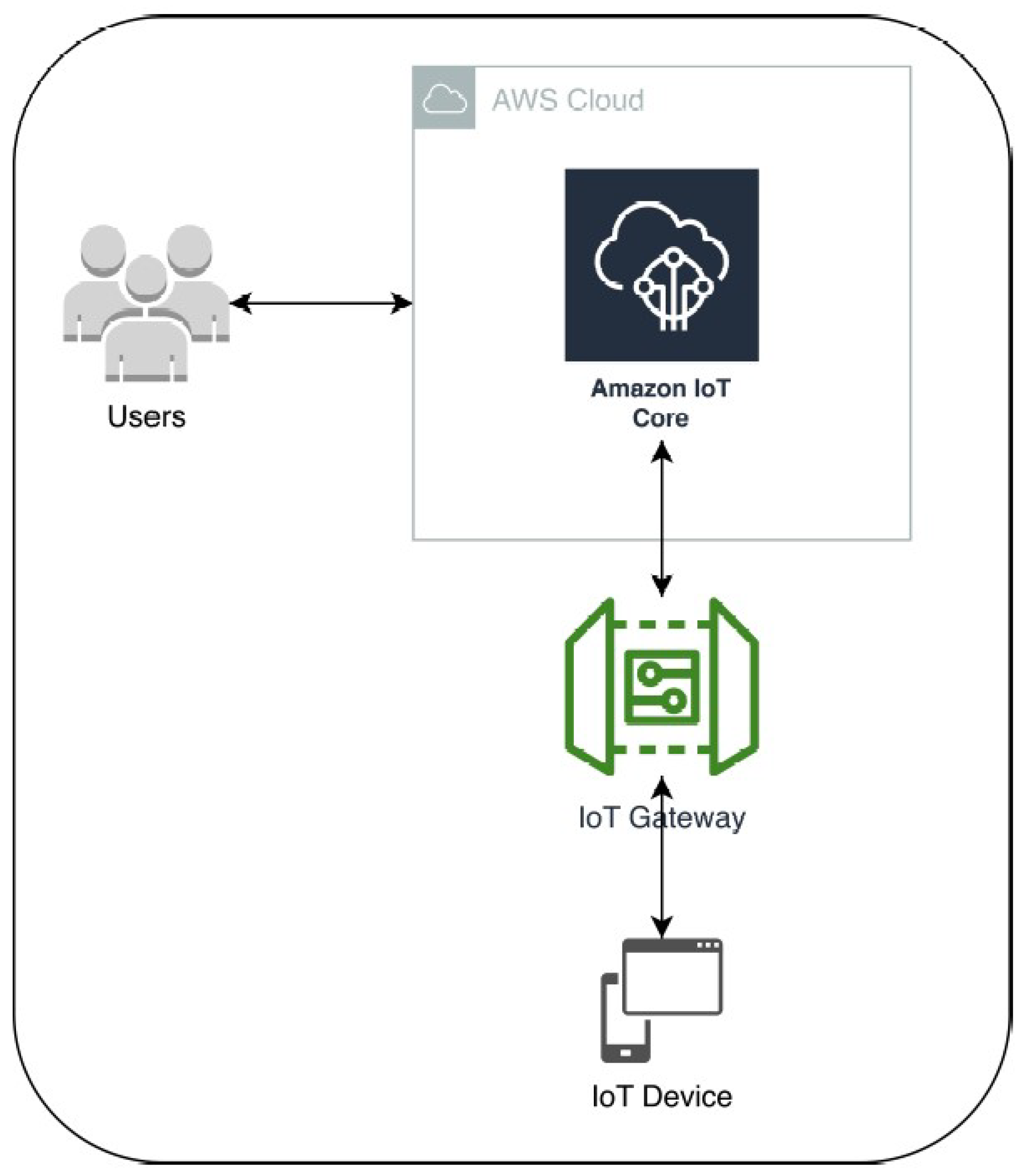
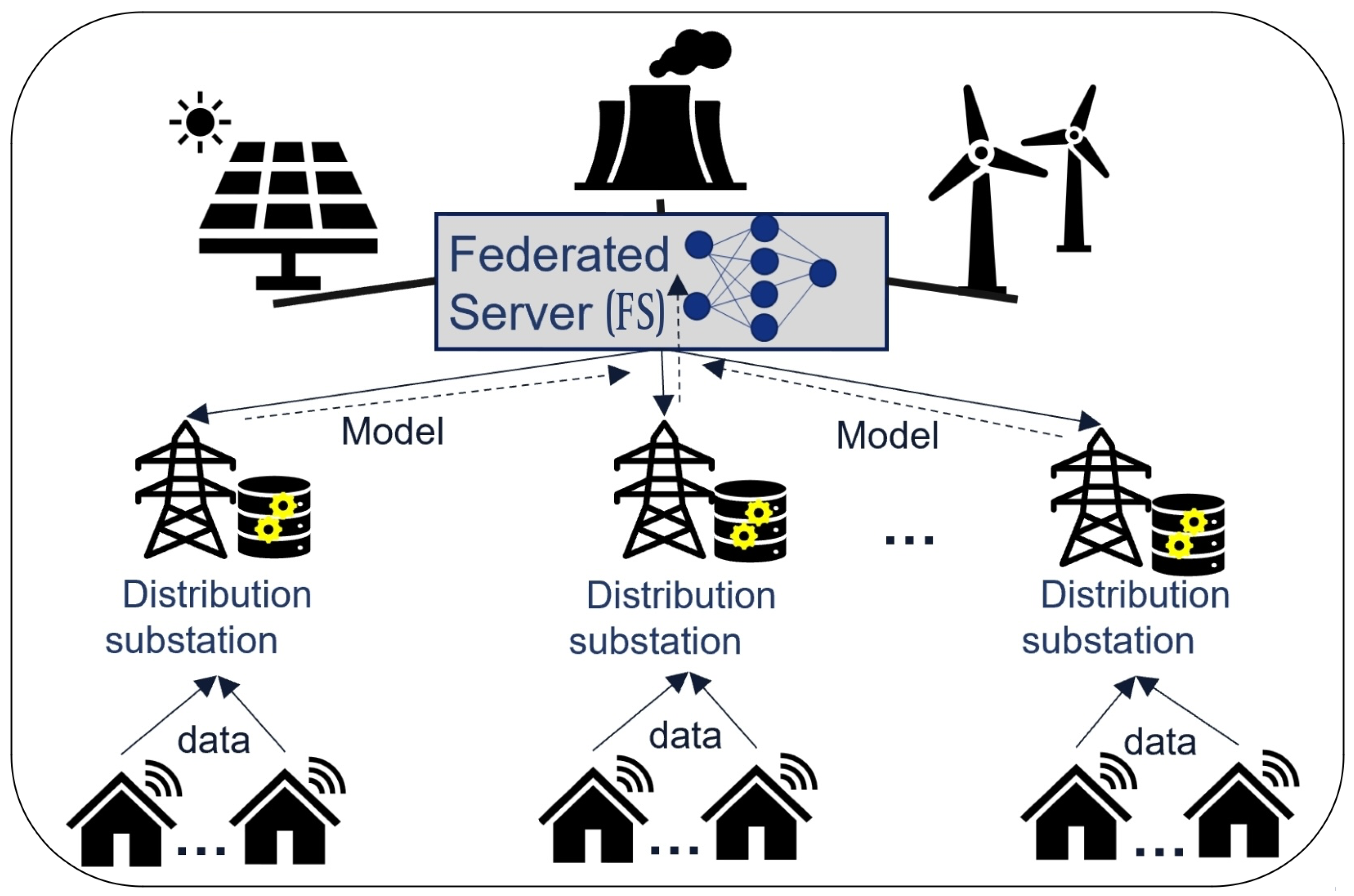
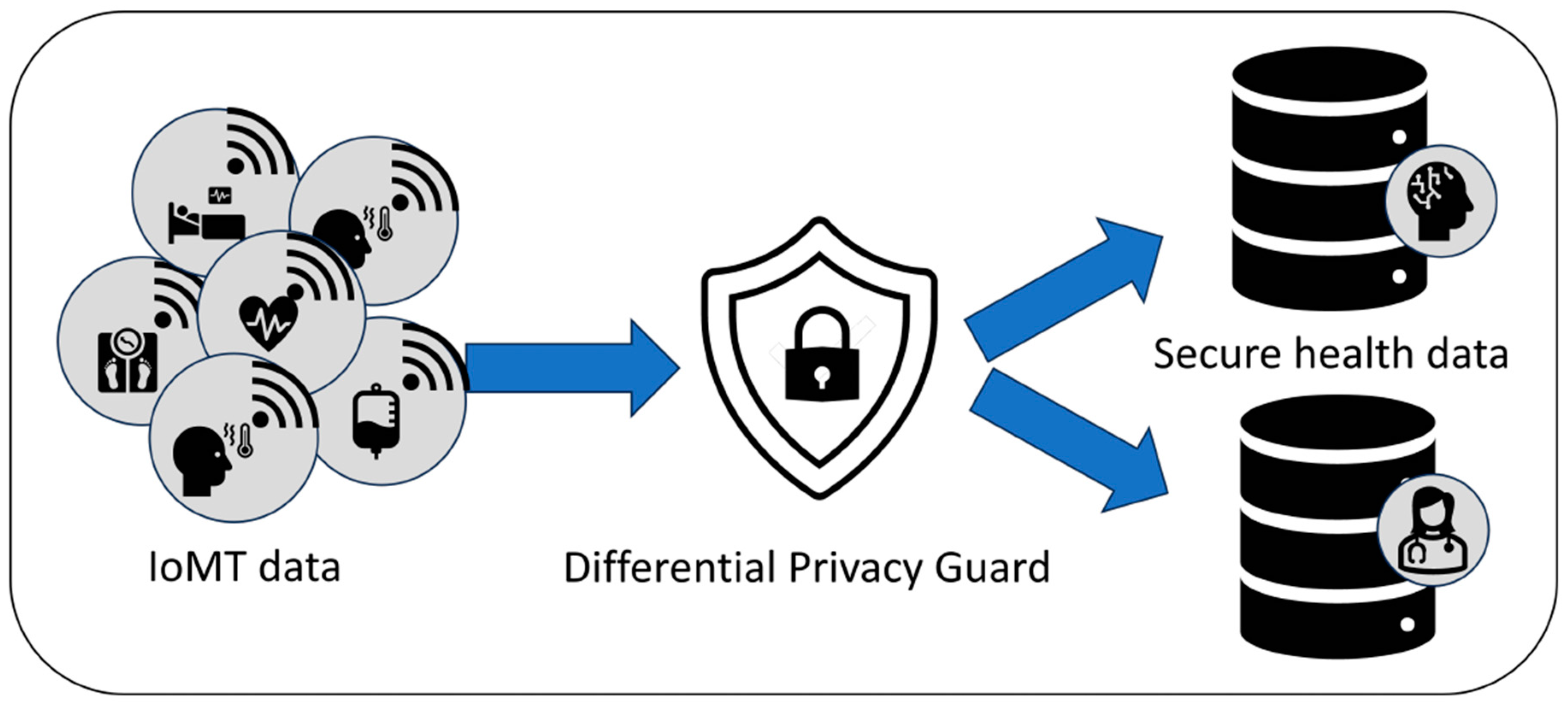
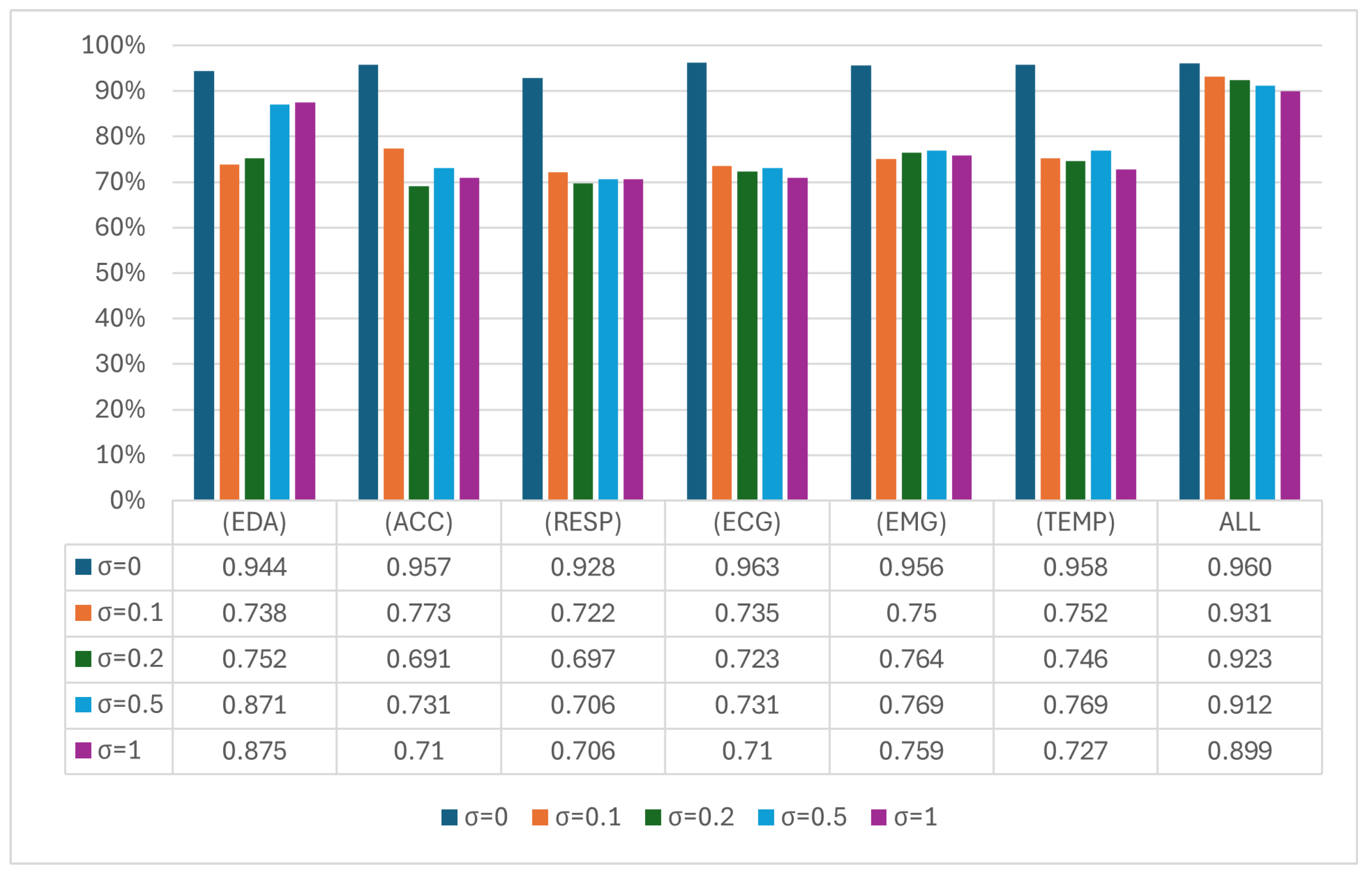
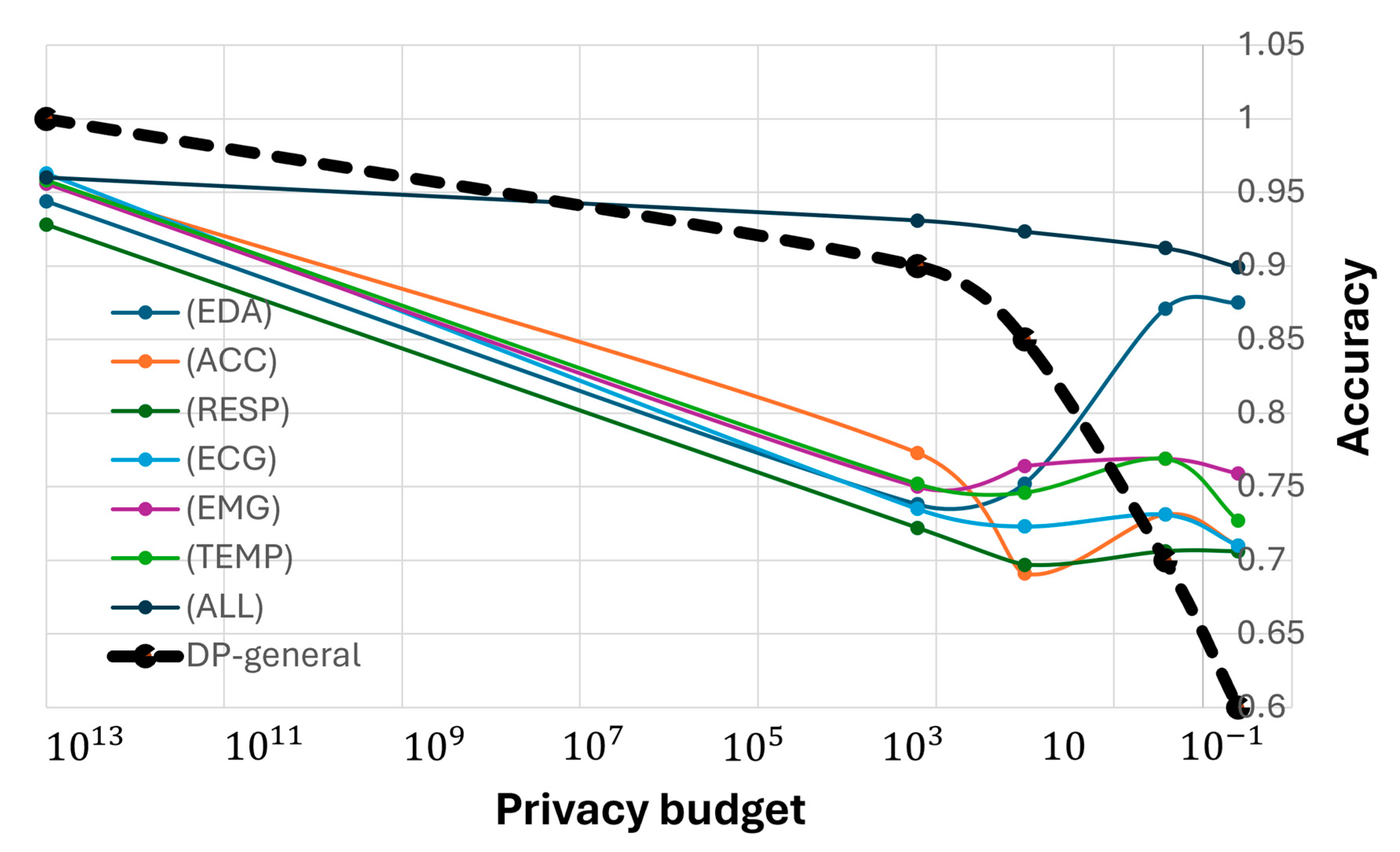
| AIS Method | IoT Device Memory Size | Accuracy | Precision | Recall | F1 Score | CPU Utilisation |
|---|---|---|---|---|---|---|
| NPS | 30 GB | 85.13% | 91.89% | 90.28% | 91.08% | 55.70% |
| 32 GB | 88.00% | 91.52% | 94.77% | 93.11% | 53.20% | |
| 64 GB | 92.20% | 94.22% | 97.35% | 95.76% | 52.80% | |
| 128 GB | 96.80% | 97.94% | 98.75% | 98.34% | 52.30% | |
| MNSA [24] | 30 GB | 68.33% | 78.91% | 73.17% | 75.95% | 85.20% |
| 32 GB | 71.00% | 80.00% | 78.87% | 79.43% | 83.95% | |
| 64 GB | 74.00% | 83.10% | 80.82% | 81.94% | 80.35% | |
| 128 GB | 76.40% | 85.71% | 81.52% | 83.57% | 78.62% |
| Parameters | Values |
|---|---|
| Number of epochs E | 10 |
| Communication rounds R | 10 |
| Number of clients C | 2, 5, 10 |
| Learning ratio | 0.001 |
| Attributes | Raw Data | Clean Data |
|---|---|---|
| Total Customers | 42,372 | 41,897 |
| Honest Customers | 38,757 | 38,321 |
| Dishonest Consumers | 3615 | 3576 |
| Outliers | 475 (39 theft) |
| Data Stream | Description | Relation to Stress |
|---|---|---|
| Electrocardiogram (ECG) | Measures heart activity | Indicates stress via heart rate variability |
| Electrodermal activity (EDA) | Measures skin conductance | Reflects emotional states |
| Temperature (Temp) | Measures skin temperature | Altered by stress-induced variations |
| Respiration (Resp) | Measures breathing patterns | Altered by stress levels |
| Accelerometer (ACC) | Captures movement data | Indicates physical restlessness due to stress |
| Electromyogram (EMG) | Measures muscle activity | Indicates muscular tension from stress |
Disclaimer/Publisher’s Note: The statements, opinions and data contained in all publications are solely those of the individual author(s) and contributor(s) and not of MDPI and/or the editor(s). MDPI and/or the editor(s) disclaim responsibility for any injury to people or property resulting from any ideas, methods, instructions or products referred to in the content. |
© 2024 by the authors. Licensee MDPI, Basel, Switzerland. This article is an open access article distributed under the terms and conditions of the Creative Commons Attribution (CC BY) license (https://creativecommons.org/licenses/by/4.0/).
Share and Cite
Alrubayyi, H.; Alshareef, M.S.; Nadeem, Z.; Abdelmoniem, A.M.; Jaber, M. Security Threats and Promising Solutions Arising from the Intersection of AI and IoT: A Study of IoMT and IoET Applications. Future Internet 2024, 16, 85. https://doi.org/10.3390/fi16030085
Alrubayyi H, Alshareef MS, Nadeem Z, Abdelmoniem AM, Jaber M. Security Threats and Promising Solutions Arising from the Intersection of AI and IoT: A Study of IoMT and IoET Applications. Future Internet. 2024; 16(3):85. https://doi.org/10.3390/fi16030085
Chicago/Turabian StyleAlrubayyi, Hadeel, Moudy Sharaf Alshareef, Zunaira Nadeem, Ahmed M. Abdelmoniem, and Mona Jaber. 2024. "Security Threats and Promising Solutions Arising from the Intersection of AI and IoT: A Study of IoMT and IoET Applications" Future Internet 16, no. 3: 85. https://doi.org/10.3390/fi16030085
APA StyleAlrubayyi, H., Alshareef, M. S., Nadeem, Z., Abdelmoniem, A. M., & Jaber, M. (2024). Security Threats and Promising Solutions Arising from the Intersection of AI and IoT: A Study of IoMT and IoET Applications. Future Internet, 16(3), 85. https://doi.org/10.3390/fi16030085







